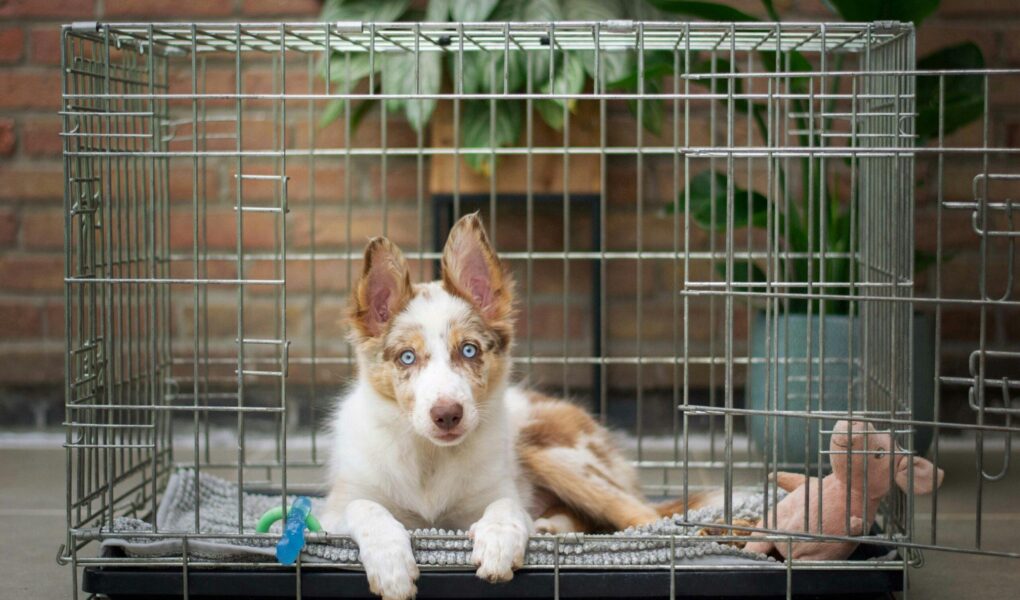In a world where the bond between humans and their furry companions grows ever tighter, the pursuit of a harmonious household often leads pet owners to explore innovative training techniques. Among these methods, dog crate training stands out as a powerful, yet sometimes misunderstood tool. While some may picture a confinement device, the crate represents much more—a safe haven, a personal retreat, and a crucial aid in nurturing a well-behaved canine. By understanding the principles of crate training, pet owners can unlock the door to a peaceful coexistence with their loyal friends, laying the groundwork for trust, security, and lasting companionship. In this article, we will delve into the ins and outs of dog crate training, revealing how it can transform both your pup’s behavior and your living space into an idyllic sanctuary of comfort and cooperation.
Table of Contents
- Understanding the Benefits of Dog Crate Training for Your Pet
- Creating a Comfortable Crate Environment to Encourage Relaxation
- Establishing a Positive Routine: Effective Techniques for Successful Training
- Addressing Common Challenges and Misconceptions in Crate Training
- Q&A
- The Way Forward
Understanding the Benefits of Dog Crate Training for Your Pet
Dog crate training offers a host of advantages that not only benefit your pet but also enhance your overall pet ownership experience. One of the most significant benefits is providing your furry friend with a safe and secure space. A crate serves as a personal retreat where your dog can relax and feel protected from external distractions. Additionally, it helps in creating a structured environment, promoting good behaviors such as house training and reducing anxiety during travel. With consistent use, your dog will come to see the crate as a haven rather than a form of punishment.
Moreover, crate training can significantly aid in managing behavioral issues. By establishing a consistent routine and encouraging positive reinforcement, owners can effectively address problems such as excessive chewing or barking. It also becomes an invaluable tool in emergencies or when hosting guests, as it allows for a safe space for your dog during potentially stressful situations. Below are some key benefits of dog crate training:
- Safety: Protects your dog from harmful situations when unsupervised.
- Convenience: Makes traveling easier and less stressful for your pet.
- Training Support: Aids in house training and managing unwanted behaviors.
- Comfort: Provides a personal space for relaxation and comfort.
Creating a Comfortable Crate Environment to Encourage Relaxation
Creating a crate environment that is both safe and inviting can significantly help your dog feel at ease. Start by placing the crate in a quiet area of the house where your dog can retreat without being disturbed. To enhance comfort, consider adding soft bedding or a cozy blanket; this will not only make the space more inviting but also give your dog a sense of security. You can also include a few familiar toys or a piece of your clothing to add a touch of familiarity and warmth, helping your pet associate the crate with positive feelings.
Additionally, controlling the crate’s atmosphere can further encourage relaxation. Ensure the crate is well-ventilated and maintain a comfortable temperature, shielding it from direct sunlight or drafts. Here are some quick tips to optimize your dog’s crate environment:
- Calming scents: Use dog-safe essential oils or calming sprays to create a soothing ambiance.
- Light dimming: If possible, keep the crate in a place where lighting can be adjusted to a soft glow.
- Routine visits: Spend quality time near the crate, rewarding your dog with treats and affection to build positive associations.
Establishing a Positive Routine: Effective Techniques for Successful Training
Creating a structured environment for your dog is essential, especially when introducing a crate. A positive routine not only aids in training but also reinforces your dog’s sense of security. Begin by establishing a consistent schedule for meals, playtime, and bathroom breaks. This predictability helps your dog understand when it’s time to relax in the crate and when to engage with you. Utilize gentle commands and rewards to encourage your dog to enter and stay in the crate willingly. Keep the crate inviting by placing comfortable bedding and favorite toys inside, making it a cozy sanctuary rather than a place of confinement.
Additionally, incorporate short training sessions into your daily routine. These can be broken down into simple techniques that promote positive associations with the crate. For instance, during the training, you can employ the following methods:
- Gradual Introduction: Start by leaving the crate door open and allowing your dog to explore at their own pace.
- Positive Reinforcement: Use treats and praise when your dog enters the crate voluntarily.
- Short Crate Sessions: Initially limit time in the crate to just a few minutes, gradually increasing as your dog becomes more comfortable.
Track your dog’s progress with a simple training log, which may look like this:
| Date | Activity | Duration | Notes |
|---|---|---|---|
| 10/01 | Introduction to Crate | 5 mins | Explored happily. |
| 10/02 | Short Crate Stay | 10 mins | Entered on command. |
| 10/03 | Positive Reinforcement | 15 mins | Responded well to treats. |
By documenting your dog’s experiences, you can identify patterns and adjust your training techniques as needed, ensuring a smooth transition to crate training.
Addressing Common Challenges and Misconceptions in Crate Training
Many pet owners fear that crate training is an act of confinement, believing that it may cause anxiety and stress for their furry companions. However, this couldn’t be further from the truth. When introduced gradually and positively, crates become a safe haven for dogs. They learn to view their crate as a cozy den rather than a prison. Some common misconceptions include:
- Crates are cruel: In reality, dogs are den animals, and they naturally seek small, enclosed spaces for comfort.
- Leaving them in a crate for long periods is fine: Dogs should not be crated for extended durations. Regular breaks and playtime are essential.
- Crate training is only for puppies: Adult dogs can also benefit significantly from crate training, whether for managing anxiety or establishing a safe space.
Another challenge often faced during crate training is the dog’s initial resistance or reluctance to enter the crate. Some tips to overcome this hurdle include using positive reinforcement techniques such as:
- Enticing the dog with treats: Place their favorite snacks inside the crate to encourage exploration.
- Creating a positive environment: Use comfortable bedding and toys to make the crate inviting.
- Gradual introductions: Start by leaving the crate door open and allowing your dog to come and go freely, slowly desensitizing them.
Q&A
Q&A: Dog Crate Training
Q1: What exactly is crate training, and why should I consider it for my dog?
A1: Crate training is the process of teaching your dog to see their crate as a safe and comfortable space, much like a den. It serves multiple purposes: providing a secure environment during travel, helping with house training, preventing destructive behaviors when you’re away, and giving your dog a cozy nook to escape to when they need a little alone time.
Q2: At what age can I start crate training my dog?
A2: You can start crate training as early as 8 weeks old! Puppies are particularly adaptable, but older dogs can also learn to love their crates with some patience and positivity. Just remember, the key is to make the crate an inviting place for them.
Q3: How do I choose the right crate for my dog?
A3: Selecting the right crate involves considering your dog’s size, breed, and preferences. Ideally, it should be large enough for them to stand up, turn around, and lie down comfortably but not so large that they feel lost in it. There are various types, such as wire crates, plastic carriers, and soft-sided options—each with its own benefits based on your dog’s behavior and your lifestyle.
Q4: What’s the best way to introduce my dog to the crate?
A4: Introduction should be a slow and positive experience. Start by placing the crate in a common area of your home. Encourage your dog to explore it using treats, toys, or their favorite blanket. Allow them to come and go freely at first, so they associate it with positive experiences. Never force them inside; instead, use praise and gentle encouragement to foster a sense of security.
Q5: How long should I keep my dog in the crate?
A5: The duration depends on your dog’s age. As a general rule, puppies can hold it for about one hour for each month of their age (up to a maximum of about 4-5 hours). Adult dogs can typically manage longer periods, around 6-8 hours, but regular breaks for potty and playtime are important to keep them happy and healthy.
Q6: What if my dog cries or barks when in the crate?
A6: It’s not uncommon for dogs to vocalize their discomfort when first crated. Avoid responding immediately to avoid reinforcing the behavior. Instead, ensure they have had ample exercise and bathroom breaks before crating. Try to provide distractions, like chew toys, and gradually increase their crate time to help them adjust.
Q7: Are there any common mistakes I should avoid during crate training?
A7: Absolutely! First, never use the crate as a form of punishment; it should remain a positive space. Also, avoid crating your dog for extended periods without breaks. don’t rush the process—every dog learns at their pace, so patience and consistency are your best tools.
Q8: How do I know if my dog has successfully adapted to the crate?
A8: A well-adjusted dog will often seek out their crate for relaxation, enter it willingly, and settle down without excessive whining or fussing. They’ll appear relaxed and comfortable when resting inside, indicating that they view the crate as a safe haven rather than a confinement.
Q9: Can crate training be beneficial for older dogs?
A9: Yes, older dogs can also benefit significantly from crate training. It can provide them with a sense of safety, assist in house training for those who may be struggling, and help manage anxiety during stressful situations, such as thunderstorms or fireworks. Just remember that patience and careful introduction are crucial for all ages.
By understanding the nuances of crate training and approaching it with care and kindness, you and your dog can build a rewarding routine that enhances your lives together!
The Way Forward
As we wrap up our exploration of dog crate training, it’s clear that this method serves as more than just a practical solution for managing your pet’s behavior; it’s a gateway to fostering a deeper bond between you and your furry companion. A crate, when introduced thoughtfully and with positive reinforcement, can transform into a safe haven where your dog feels secure and grounded. Remember, patience and consistency are your allies in this journey—each small step taken today builds a foundation for a well-adjusted companion tomorrow. So as you embark on this training adventure, know that with love and care, you’re not just teaching your dog where to stay; you’re nurturing trust and understanding that will last a lifetime. Happy training!



